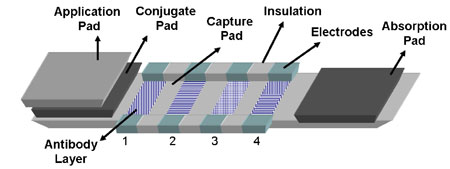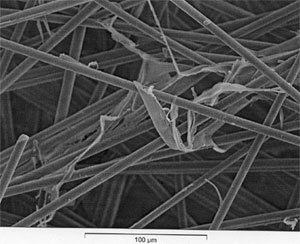| Posted: Sep 28, 2007 | |
Reliably detecting foodborne pathogens with nanotechnology and encoding/decoding techniques |
|
| (Nanowerk Spotlight) Every few months you can read about a recall of food items, be it fresh spinach of bottled infant formula, due to contamination with salmonella, E. coli or some other foodborne pathogen. A pathogen is a an organism that causes disease in another organism. The Centers for Disease Control and Prevention (CDC) estimates that foodborne diseases cause 76 million illnesses, 325,000 hospitalizations, and 5,000 deaths each year. In 2000, the U.S. Department of Agriculture (USDA) estimated the costs associated with five major bacterial foodborne pathogens to be $6.9 billion. | |
| The Food and Drug Administration’s (FDA’s) 2005 Food Code states that the estimated cost of foodborne illness is $10–$83 billion annually. These staggering numbers, not to mention the potential of foodborne pathogens for terrorists attacks, are driving the development of biosensors as important analytical tools for the rapid detection of pathogens in the field, and they are increasingly playing a key role in controlling disease outbreaks. Immunosensors (biosensors that use antibodies as biological recognition elements) are of great interest because of their applicability (any compound can be analyzed as long as specific antibodies are available) and high sensitivity. | |
| High sensitivity, of course, is an important attribute in designing biosensors, but a large variance due to stochastic interaction between biomolecules, biosensor imperfections, and environmental variability (e.g., pH of the analyte) directly affects the reliability of the measured signal in almost all sensors. Researchers have now taken forward error-correction (FEC) techniques, already successfully applied for improving reliability of communication and storage systems such as CDs, and applied them to biosensors. | |
| "With embedded forward error-correction function in biosensors, with the result that our multi-array biosensor not only can detect multiple pathogens simultaneously, but also could correct for errors induced by artifacts in biosensors and environment, thus increasing the accuracy and reliability of biosensors" Shantanu Chakrabartty explains to Nanowerk. "In our recent work we have demonstrated that we can successfully construct basic logic circuits (AND and OR) using computational primitives inherent in antigen-antibody interaction. The operation of these logic gates relies on selective conjugation of polyaniline (PANI) nanowires with an antigen-antibody complex. We have also developed corresponding electrical models for these logic gates which can be now be used in computer-aided design of biosensors." | |
 |
|
| Visualization of the final multi-array biosensor prototype (Reprinted with permission from IOP Publishing) | |
| Chakrabartty, an Assistant Professor and Director of the Adaptive Integrated Microsystems Laboratory at Michigan State University, led the work that has been reported in a recent paper in Nanotechnology ("Fundamental building blocks for molecular biowire based forward error-correcting biosensors") where he, together with first author Yang Liu and Associate Professor Evangelyn C. Alocilja describes the fabrication, characterization and modeling of fundamental logic gates that can be used for designing biosensors with FEC. | |
| Chakrabartty says that there exists an extensive body of literature documenting how proteins can perform logical operations. "However, to our knowledge, this work is one of the first attempts to build biosensor encoders based onforward error-correcting principles. The fundamental building blocks are equivalent to bio-molecular transistors whose properties change due to presence or absence of pathogens. In the future, we will interface the transistor array with a silicon processor which can decode the encoded biosensor signals." | |
| The researchers constructed AND logic gates by cascading B. cereus and E. coli antibodies, whereas OR logic gates have been fabricated by homogeneously mixing and dispensing of antibodies. The immunosensor logic gates utilize conductive polyaniline nanowire as the transducer in conjunction with specific antigen–antibody binding. | |
 |
|
| A polyaniline nanowire functionalized with antibodies (Reprinted with permission from IOP Publishing) | |
| "Experimental results show that the change in conductance across the gates can be modeled using a log-linear response with respect to varying pathogen concentration" says Liu. "We have presented equivalent circuit models for AND and OR logic gates and we have calculated the model parameters using measured results." | |
| Traditionally, FEC techniques have been successfully applied for improving reliability of communication and storage systems. For instance, compact disk technology owes its success to high-performance encoding techniques that can compensate for fabrication and measurement errors. The Michigan team's long term objective is to replicate similar success in biosensor technology whose performance is currently limited by artifacts introduced by stochastic interaction between proteins and biosensor device artifacts. | |
| As an example for the need for high-sensitivity and extremely reliable biosensors, the researchers note that reliable detection of pathogens at low concentration levels is especially important for certain pathogens (also referred to as zero-tolerance pathogens) where trace quantities have been shown to be dangerous for human ingestion. For instance, the US Food Safety and Inspection Service (FSIS) has established a zero tolerance threshold for E. coli O157:H7 contamination in raw meat products. The infectious dosage of E. coli O157:H7 is ten cells; the Environmental Protection Agency (EPA) standard in water is 40 cells per liter. | |
| Although, for this particular research, Liu and his colleagues have chosen a specific kind of biosensor (lateral flow immunosensor), they believe their work will be generic enough to be applicable to many existing biosensor technology, like microarray technology. Apart from improving the sensitivity of biosensors, Chakrabartty sees some promising future applications: | |
| "Imagine a biosensor compact disk which contains a large array of the proposed logic gates. When a biological sample is applied to this disk, the logic gates change its electrical properties in a specific pattern which reliably encodes the pathogens present in the sample. Due to forward error-correction, the detection result could be robust to any environmental conditions, enabling the usage of the array under non-laboratory conditions." | |
| Another application of the proposed work could be the development of computer-aided design (CAD) tools which can assist biosystem engineers to pattern and test biosensors in a virtual environment. Traditionally biosensor experiments are very time consuming, labor extensive, and are expensive. | |
| "With our developed computational and electrical models, the building blocks can be configured, connected in arbitrary fashion and tested using computer simulations" says Liu. | |
| There are still several theoretical and experimental issues that are required to be addressed before a practical biosensor CD-like technology becomes feasible and deployable. Some of the theoretical questions arise from the area of coding theory where the scientists have to address fundamental limitations on the number and concentration levels at which the biosensor system can reliably detect pathogens. Also, questions like, whether there exist unique computation primitives in protein interaction which can lead to development of powerful encoding schemes. | |
| "In the area of device fabrication, several issues related with biosensor construction needs to be addressed" says Chakrabartty. "Accurate patterning of logic gates will require use of precise dispensing schemes. However, we hope that some of these fabrication errors can be directly compensated by the FEC techniques." | |
 By
Michael
Berger
– Michael is author of three books by the Royal Society of Chemistry:
Nano-Society: Pushing the Boundaries of Technology,
Nanotechnology: The Future is Tiny, and
Nanoengineering: The Skills and Tools Making Technology Invisible
Copyright ©
Nanowerk LLC
By
Michael
Berger
– Michael is author of three books by the Royal Society of Chemistry:
Nano-Society: Pushing the Boundaries of Technology,
Nanotechnology: The Future is Tiny, and
Nanoengineering: The Skills and Tools Making Technology Invisible
Copyright ©
Nanowerk LLC
|
|
|
Become a Spotlight guest author! Join our large and growing group of guest contributors. Have you just published a scientific paper or have other exciting developments to share with the nanotechnology community? Here is how to publish on nanowerk.com. |
|
